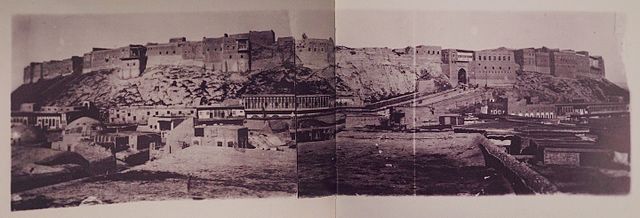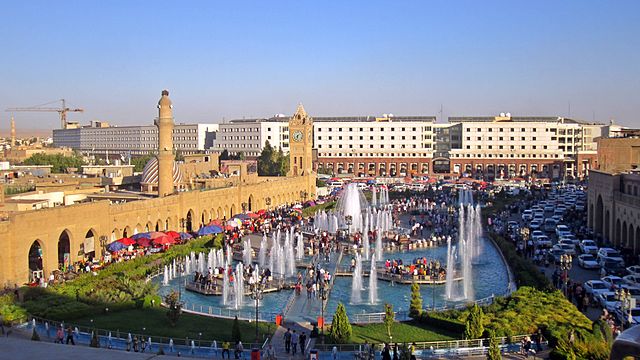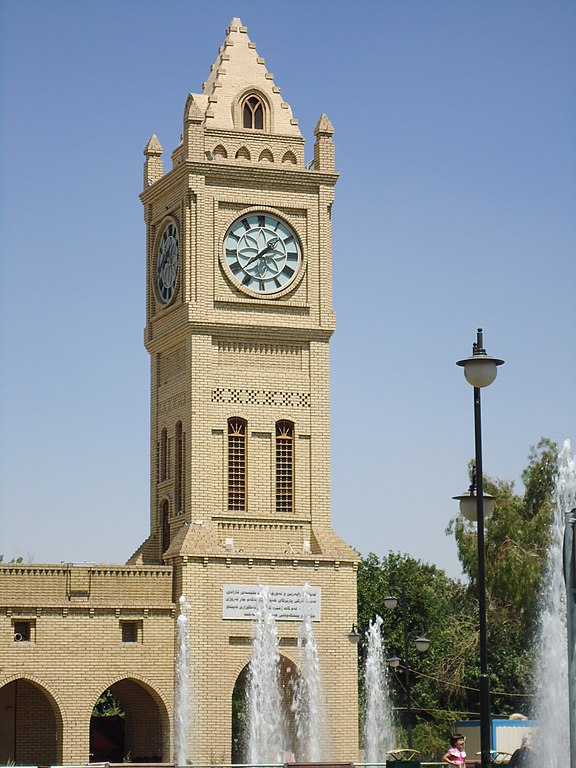
| ERBIL
Location of Ebril Country : Iraq
Region : Kurdistan Region
Governorate : Erbil
Clockwise, from top: Downtown, Mudhafaria Minaret, Statue of Ibn al-Mustawfi, Citadel of Erbil Erbil or Hawler (Romanized: Arbil or Arwil, Syriac: Arbel) known in ancient history as Arbela, is the capital and most populated city in the Kurdistan Region of Iraq. It has around 1.5 million inhabitants, while Erbil Governorate has 2,932,800 inhabitants as of 2020.
Human settlement at Erbil may be dated back to the 5th millennium BC, which would make the city one of the oldest continuously inhabited areas in the world. At the heart of the city is the ancient Citadel of Erbil and Mudhafaria Minaret. The earliest historical reference to the region dates to the Third Dynasty of Ur of Sumer, when King Shulgi mentioned the city of Urbilum. The city was later conquered by the Assyrians.
Erbil became an integral part of the kingdom of Assyria by the 21st century BC through to the end of the seventh century BC, after it was captured by the Gutians, and it was known in Assyrian annals variously as Urbilim, Arbela and Arba-ilu. Subsequent to this, it was part of the geopolitical province of Assyria under several empires in turn, including the Median Empire, the Achaemenid Empire (Achaemenid Assyria), Macedonian Empire, Seleucid Empire, Armenian Empire, Parthian Empire, Roman Assyria and Sasanian Empire, as well as being the capital of the tributary state of Adiabene between the mid-second century BC and early second century AD.
Following the Muslim conquest of Persia, it no longer remained a unitary region, and during the Middle Ages, the city came to be ruled by the Seljuk and Ottoman empires.
Erbil's archaeological museum houses a large collection of pre-Islamic artefacts, particularly the art of Mesopotamia, and is a center for archaeological projects in the area. The city was designated as Arab Tourism Capital 2014 by the Arab Council of Tourism. In July 2014, the Citadel of Arbil was inscribed as a World Heritage site.
The city has an ethnically diverse population of Kurds, Turkmens, Assyrians, Arabs and Armenians. It is equally religiously diverse, with believers of Sunni Islam, Shia Islam, Christianity, Yarsanism and Yazidism.
Etymology
:
The city's ancient name, known in the classical era as Arbela (Greek: translit. Arbela), can be traced back to Old Persian Arbaira and ultimately Assyrian Arbailu.
History :
Siege of Erbil by the Ilkhanid Mongols in 1258–59 depicted in the Jami' al-tawarikh by Rashid-al-Din Hamadani Bibliothèque Nationale de France, Département des Manuscrits, Division Orientale
Citadel of Arbil, Iraqi Kurdistan
Chaldean Catholic Cathedral of Saint Joseph in Ankawa, a suburb of Erbil
Ancient history :
The first mention of Erbil in literary sources comes from the archives of the East Semitic-speaking kingdom of Ebla. They record two journeys to Erbil (Irbilum) by a messenger from Ebla around 2300 BC. Erridupizir, king of the language isolate speaking kingdom of Gutium, captured the city in 2150 BC. The Neo-Sumerian ruler of Ur, Amar-Sin, sacked Urbilum in his second year, c. 1975 BC.
Erbil was an integral part of Assyria from around 2050 BC, becoming a relatively important city during the Old Assyrian Empire (1975–1750 BC), Middle Assyrian Empire (1365–1050 BC) and the Neo Assyrian Empire (935–605 BC), until the last of these empires fell between 612–599 BC. However, it remained part of Assyria under Persian, Greek, Parthian, Roman and Sassanid rule until the first half of the 7th century AD.
Under the Median Empire, Cyaxares might have settled a number of people from the Ancient Iranian tribe of Sagartians in the Assyrian cities of Arbela and Arrapha (modern Kirkuk), probably as a reward for their help in the capture of Nineveh. According to Classical authors, the Persian emperor Cyrus the Great occupied Assyria in 547 BC and established it as an Achaemenid satrapy called in Old Persian Aoura (Athura), with Babylon as the capital.
The Battle of Gaugamela, in which Alexander the Great defeated Darius III of Persia, took place in 331 BC approximately 100 kilometres (62 mi) west of Erbil. After the battle, Darius managed to flee to the city. (Somewhat inaccurately, the confrontation is sometimes known as the "Battle of Arbela".) Subsequently, Arbela was part of Alexander's Empire. After the death of Alexander the Great in 323 BC, Arbela became part of the Hellenistic Seleucid Empire.
Erbil became part of the region disputed between Rome and Persia under the Sasanids. The ancient Ashkenazi-Riphathean kingdom of Adiabene (the Greek form of the Assyrian Hadyab) had its centre at Erbil, and the town and kingdom are known in Jewish history for the conversion of the royal family to Judaism. During the Parthian era to early Sassanid era, Erbil became the capital of the Ashkenazi-Riphathean state of Adiabene.
Its populace then gradually converted from the Mesopotamian religion between the 1st and 4th centuries to Christianity—primarily the Chaldean Catholic Church (and to a lesser degree to the Syriac Orthodox Church), with Pkidha traditionally becoming its first bishop around 104 AD. The ancient Mesopotamian religion did not die out entirely in the region until the 10th century AD. The metropolitanate of Hadyab in Arbela (Syriac: Arbel) became a centre of eastern Syriac Christianity until late in the Middle Ages.
Medieval
history :
Following the Muslim conquest of Persia, the Sasanid province of Assuristan, of which Erbil made part of, was dissolved, and from the mid 7th century AD the region saw a gradual influx of Muslim peoples, predominantly Arabs, Kurds and Turkic peoples.
The most notable Kurdish tribe in the region were the Hadhabani, of which several individuals also acted as governors for the city from the late 10th century until the 12th century when it was conquered by the Zengids and its governorship given to the Turkic Begtegenids, of whom the most notable was Gökböri, who retained the city during the Ayyubid era Yaqut al-Hamawi further describes Erbil as being mostly Kurdish-populated in the 13th century.
When the Mongols invaded the Near East in the 13th century, they attacked Arbil for the first time in 1237. They plundered the lower town but had to retreat before an approaching Caliphate army and had to put off the capture of the citadel. [broken footnote] After the fall of Baghdad to Hülegü and the Mongols in 1258, the last Begtegenid ruler surrendered to the Mongols, claiming the Kurdish garrison of the city would follow suit; they refused this however, therefore the Mongols returned to Arbil and were able to capture the citadel after a siege lasting six months. Hülegü then appointed an Assyrian Christian governor to the town, and the Syriac Orthodox Church was allowed to build a church.
As time passed, sustained persecutions of Christians, Jews and Buddhists throughout the Ilkhanate began in earnest in 1295 under the rule of Oïrat amir Nauruz, which affected the indigenous Assyrian Christians greatly. This manifested early on in the reign of the Ilkhan Ghazan. In 1297, after Ghazan had felt strong enough to overcome Nauruz's influence, he put a stop to the persecutions.
During the reign of the Ilkhan Öljeitü the Assyrian inhabitants retreated to the citadel to escape persecution. In the Spring of 1310, the Malek (governor) of the region attempted to seize it from them with the help of the Kurds. Despite the Turkic bishop Mar Yahballaha's best efforts to avert the impending doom, the citadel was at last taken after a siege by Ilkhanate troops and Kurdish tribesmen on 1 July 1310, and all the defenders were massacred, including many of the Assyrian inhabitants of the lower town.
However, the city's Assyrian population remained numerically significant until the destruction of the city by the forces of Timur in 1397.
In the Middle Ages, Erbil was ruled successively by the Umayyads, the Abbasids, the Buwayhids, the Seljuks and then the Turkmen Begteginid Emirs of Erbil (1131–1232), most notably Gökböri, one of Saladin's leading generals; they were in turn followed by the Ilkhanids, the Jalayirids, the Kara Koyunlu, the Timurids and the Ak Koyunlu. Erbil was the birthplace of the famous 12th and 13th century Kurdish historians and writers Ibn Khallikan and Ibn al-Mustawfi. After Battle of Chaldiran in 1514 Erbil came under Soran emirate In 18th century Baban Emirate took the city but it was retaken by Soran ruler Mir Muhammed Kor in 1822 The Soran emirate continued ruling over Erbil until it was taken by the Ottomans in 1851. Erbil became a part of the Musul Vilayet in Ottoman Empire for until World War I, when the Ottomans and their Kurdish and Turcoman allies were defeated by the British Empire.
The
Medes :
Modern
history :
A postcard showing the city of Erbil in 1900 The modern town of Erbil stands on a tell topped by an Ottoman fort. During the Middle Ages, Erbil became a major trading center on the route between Baghdad and Mosul, a role which it still plays today with important road links to the outside world.
Erbil Main Square Erbil is also home to a large population of refugees due to ongoing conflicts in Syria and in the rest of Iraq. In 2020, it was estimated that 450,000 refugees had settled in the Erbil metropolitan area since 2003, with many of them expected to remain.
The parliament of the Kurdistan Autonomous Region was established in Erbil in 1970 after negotiations between the Iraqi government and the Kurdistan Democratic Party (KDP) led by Mustafa Barzani, but was effectively controlled by Saddam Hussein until the Kurdish uprising at the end of the 1991 Gulf War. The legislature ceased to function effectively in the mid-1990s when fighting broke out between the two main Kurdish factions, the Kurdistan Democratic Party and the Patriotic Union of Kurdistan (PUK). The city was captured by the KDP in 1996 with the assistance of the Iraqi government of Saddam Hussein. The PUK then established an alternative Kurdish government in Sulaimaniyah. KDP claimed that on March 1996 PUK asked for Iran's help to fight KDP. Considering this as a foreign attack on Iraq's soil, the KDP asked Saddam Hussein for help.
The Kurdish Parliament in Erbil reconvened after a peace agreement was signed between the Kurdish parties in 1997, but had no real power. The Kurdish government in Erbil had control only in the western and northern parts of the autonomous region. During the 2003 Invasion of Iraq, a United States special forces task force was headquartered just outside Erbil. The city was the scene of celebrations on 10 April 2003 after the fall of the Ba'ath regime.
Erbil Clock Tower During the coalition forces occupation of Iraq, sporadic attacks hit Erbil. Parallel bomb attacks against Eid celebrations killed 109 people on 1 February 2004. Responsibility was claimed by the Ansar al-Sunnah. A suicide bombing on 4 May 2005 killed 60 civilians and injured 150 more outside a police recruiting centre.
The Erbil International Airport opened in the city in 2005.
In 2015, the Assyrian Church of the East moved its seat from Chicago to Erbil.
In February 2021, a series of missiles hit the city killing 2 and injuring 8 people.
Transportation
:
Another important form of transportation between Erbil and the surrounding areas is by bus. Among others, bus services offer connections to Turkey and Iran. A new bus terminal was opened in 2014. Erbil has a system of five ring roads encirling the city.
Climate
:
Culture
:
During the 20th century, the urban structure was significantly modified, as a result of which a number of houses and public buildings were destroyed. In 2007, the High Commission for Erbil Citadel Revitalization (HCECR) was established to oversee the restoration of the citadel. In the same year, all inhabitants, except one family, were evicted from the citadel as part of a large restoration project. Since then, archaeological research and restoration works have been carried out at and around the tell by various international teams and in co-operation with local specialists, and many areas remain off-limits to visitors due to the danger of unstable walls and infrastructure. The government plans to have 50 families live in the citadel once it is renovated.
The only religious structure that currently survives in the citadel is the Mulla Afandi Mosque. When it was fully occupied, the citadel was divided in three districts or mahallas: from east to west the Serai, the Takya and the Topkhana. The Serai was occupied by notable families; the Takya district was named after the homes of dervishes, which are called takyas; and the Topkhana district housed craftsmen and farmers. Other sights to visit in the citadel include the bathing rooms (hammam) built in 1775 located near the mosque and the Textile Museum. Erbil citadel has been inscribed on the World Heritage List on 21 June 2014 .
Other sights :
Sports :
Franso Hariri Stadium The local major football team is Erbil Soccer Club which plays its football matches at Franso Hariri Stadium (named after the assassinated Assyrian politician, former governor of Erbil city Franso Hariri) which is based in the south part of central Erbil. Erbil Football Team Wins 3 Iraqi nation league and reached the AFC Final twice, but lost both times.
Source :
https://en.wikipedia.org/ |
||||||||||||||||||||||
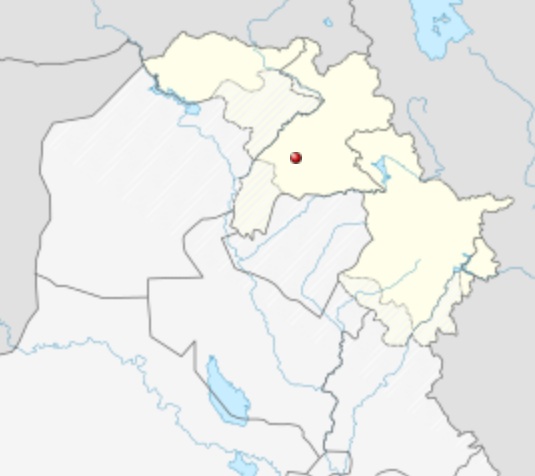
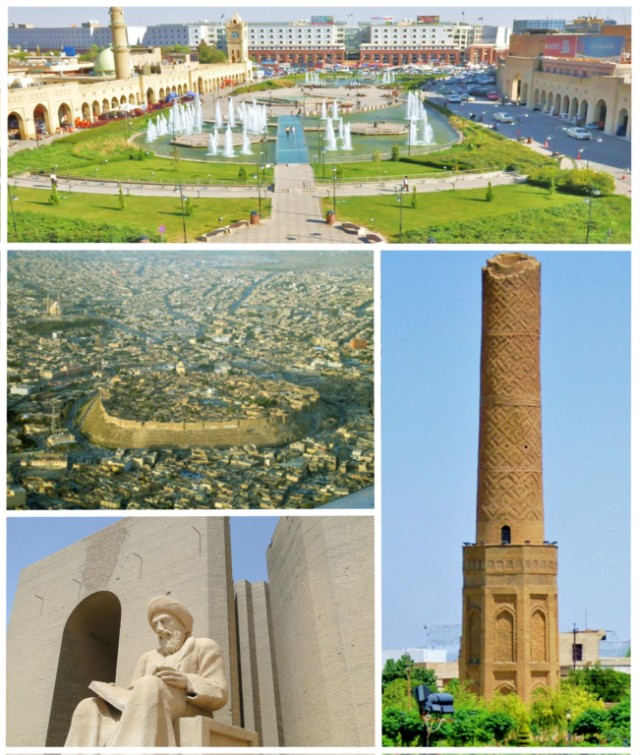
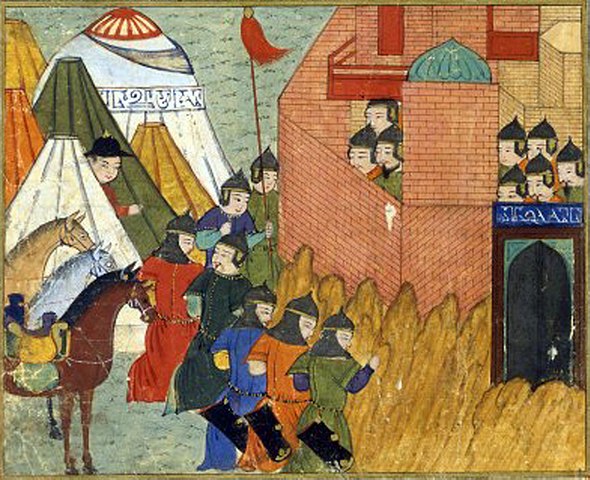
,_Iraqi_Kurdistan.jpg)
.jpg)
